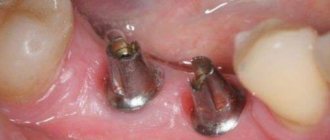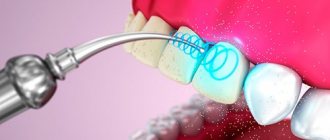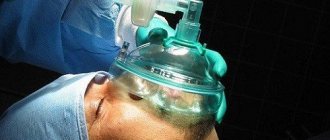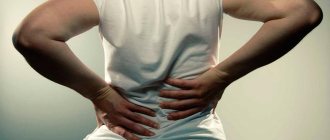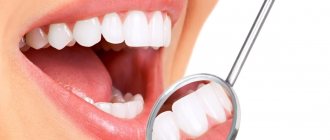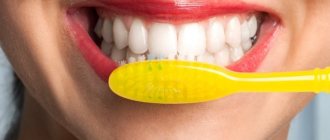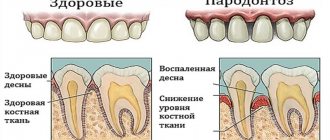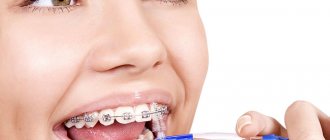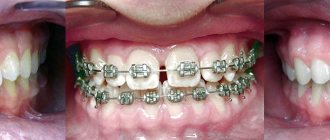Does it hurt to get braces?
Installation of braces is carried out in several stages:
- First, the doctor removes plaque from the teeth and treats them thoroughly. Such procedures allow you to protect the patient from various diseases for a whole year while wearing braces.
- Enamel processing. This procedure is necessary so that the elements of the system are well attached to the surface of the teeth.
- Fixation of the system on the teeth.
The procedure for installing braces takes approximately 3 hours. It is completely painless. In some situations, patients are advised to remove some teeth to make room for the correct placement of the remaining teeth. It is important to understand that dentists are trying to preserve the smile as much as possible.
Causes of pain when wearing braces
Strong arc pressure. In order for the tooth to move in the right direction, a special iron plate is installed on it. The arc puts pressure on the ligaments, bone tissue and the tooth itself. You can feel pain immediately when the system is installed or corrected. A person will not feel unpleasant symptoms for long.
Irritation of the oral mucosa. If unpleasant symptoms appear as a result of the braces touching the inside of the cheek, dentists use special orthodontic wax. It is attached to the elements of the system to eliminate discomfort.
Mixing the lock. If such deformation occurs, the metal structure can injure soft tissues. This can happen while chewing hard food. The orthodontist will install the displaced lock in its original place without any difficulties.
Development of caries. Despite the fact that teeth are treated before installing a braces system, sometimes situations arise when they begin to hurt again. In such a situation, the installation is removed to cure caries. After this, the braces are attached back to their place.
A piece of the spring is sticking out. The spring part of the braces is under compression, connecting all the pads together. Its edge may stick out if the doctor made a mistake or the system has failed due to frequent intake of solid food. The problem can be resolved in a clinical setting. If necessary, wax can be temporarily attached.
The appearance of an allergic reaction. Allergies often occur when braces are made from low-quality materials. If medications do not help eliminate allergic symptoms, then patients need to choose a dental appliance made from other materials.
DETAILS: I want to put braces on my teeth in
Many people are interested in how long it takes for the pain to go away. The answer to this question cannot be unambiguous. The duration of discomfort is related to the cause of its occurrence. If there are no mechanical defects and pain is determined only by habituation, then a week is enough to eliminate the unpleasant sensations.
What does dull or cutting pain in a tooth mean?
A tooth hurts due to pathological dental disorders, injuries, errors during treatment, and allergic reactions. Many advanced cases are associated with the reluctance of adult patients to see a dentist due to a number of psychological factors. At the same time, the risk of tooth loss develops.
A dull pain in a tooth is a sign of a dental problem.
For dull and aching pain, we can talk about:
- Periodontal disease is the degradation of tissue at the support where the root meets the jaw bone.
- Periodontitis is an inflammatory process at the base of the tooth.
- Violation of the integrity of the enamel due to a violation of the mineral composition.
- Allergic reactions to medications during the provision of dental services.
- Congenital thinning of enamel. The pathology is called hypoplasia. Develops against the background of malocclusion. Significantly increases the level of sensitivity.
- Cysts on the roots of the tooth (granuloma). Treatment often involves surgery. The conservative method is effective only in the early stages of development.
Acute cutting pain is associated with deep caries or pulpitis.
Other causes of acute pain include:
- Jaw injury.
- Getting a solid body into the space between the teeth (for example, a piece of food).
- Root suppuration as a result of infection of the bloodstream.
- Violation of filling techniques and caries treatment.
It is possible to completely eliminate the pain syndrome only at an appointment with a dentist, after making a final diagnosis. The choice of treatment, the selection of medications, and the completion of a number of medical procedures depend on it.
Tests may be prescribed to test for allergies to various irritants. After the initial examination, radiography is prescribed.
The result will be the loss of several teeth, complicated medical procedures, and significant financial costs to restore the normal state of the oral cavity.
If left untreated, allergies may have consequences such as:
- Quincke's edema;
- anaphylactic shock.
Materials that trigger the development of minimal allergy symptoms may remain in the jaw for a long time. As a result of the constant stimulation of the immune response to irritants, the entire body begins to experience increased sensitivity to allergens.
Consequences such as angioedema and anaphylactic shock can be fatal without immediate medical attention. The airways may be blocked. Prolonged asphyxia will cause death.
To eliminate the cause, an appropriate method is selected. Periodontal disease and periodontitis require complex treatment, including:
- Bite correction.
- Implantation of missing teeth.
- Removal (if there is crowding in certain places).
- Pharmaceutical therapy (immunostimulating drugs, drugs that improve blood supply to the damaged area).
Enamel pathologies are eliminated by applying a special composition that eliminates cracks and chips, and also normalizes the level of minerals.
The pharmaceutical method of treating cysts is possible only in the early stages of the development of the pathology, when there is no threat of tooth loss. In later stages, surgical treatment options are indicated.
Innovative developments are used:
- ultraviolet irradiation;
- ultrasound treatment;
- massage effect on damaged gums.
A course of antibiotics is often prescribed. During surgery, not only the granuloma is removed, but also adjacent tissues that have undergone pathological changes.
If there is an abscess, the doctor will open the purulent formation and clean the damaged area. In special cases, drainage is installed.
To remove deposits on teeth, professional cleaning is prescribed. The procedure is mostly painless. Inexpensive. It is recommended for preventive purposes to undergo it once every six months.
In case of poor-quality tooth filling, removal of the old material and re-filling is prescribed with quality control using x-rays.
Withdrawal procedure
Another common myth is the pain experienced during the removal of braces. As during installation of the structure, the doctor does not have any effect on the nerve endings.
And if the work is done carefully, then the pressure on the gum tissue is minimal. Therefore, it is simply physiologically impossible for pain to arise. And where can such gloomy thoughts even come from if today you have to see your new smile!
After removing the braces, aching pain in the teeth may appear, due to the abrasion of the enamel and an increase in its sensitivity.
Usually these sensations are not intense and can be easily eliminated with the help of remineralizing therapy, during which you will be offered to cover the enamel with a restorative composition and use special pastes.
It is important to understand that wearing braces is only the first stage of treatment. And to consolidate the results obtained, you will have to wear the mouth guards for some time.
Otherwise, the achieved result will not last long, and soon the teeth will again begin to return to their usual position.
The duration and pattern of wearing the mouth guards is selected individually. In some cases, the period of consolidation therapy extends for several years.
But the patient does not experience any pain at this time. And the appearance of unpleasant sensations indicates that the drawn up scheme is not suitable for holding the teeth in the desired position.
Details of the removal of the structure can be seen in the video.
Some are afraid of it when it comes time to remove the system, but in fact everything is painless here, since the teeth have taken the required position, and the braces no longer put pressure on them.
First, the braces themselves are removed, and then the teeth are polished to remove any glue. How to relieve pain:
- eat soft food;
- you can resort to temporary numbness with ice cream or ice;
- do not drink or eat acidic foods, which can get into wounds and increase pain;
- chew sugar-free gum;
- no hard or sticky food;
- taking painkillers;
- rinsing with salt or diluted peroxide;
- use orthodontic wax;
- Follow your doctor's advice to properly brush your teeth.
You may also be interested in the article about
At what age can you get braces?
.
Read the article about how plates are installed to straighten teeth.
Here
.
You may also find this article about
Incognito braces
.
If there is an incomprehensible, severe pain, then you should consult a doctor who can deal with the problem.
Brushing teeth with braces
After installing braces, you should follow some rules:
- Buy toothpastes for sensitive teeth. These cleaning products often contain potassium nitrate. It reduces sensitivity and protects nerve endings.
- Use soft bristle brushes. There are brushes with hard, medium and soft bristles. The latter option allows you to gently brush your teeth.
- Brush your teeth gently. If previously the patient could rub his teeth vigorously, now the movements should be light and gentle. You need to take your time and try to open your mouth wide. If you brush your teeth poorly, plaque will accumulate on them, which will later turn into caries.
- Flossing. After eating, you should brush your teeth using dental floss. This is necessary in order to eliminate leftover food. It is best to carry a small toothbrush with toothpaste, as well as the dental floss itself, so that after each meal you can carry out the necessary hygiene procedures.
Orthodontic treatment lasts a long time and it does not end after the braces are removed, as many people think. Thanks to the use of such a system, you can get a bite correction and a Hollywood smile. After correction, it is necessary to consolidate the result obtained. To do this, retainers are installed. Wearing them will be much more comfortable and pain-free. After removing braces, you should restore your teeth using special gels, pastes and varnishes.
How to reduce pain from wearing braces
If discomfort in the oral cavity is associated specifically with the body’s reaction to orthodontic structures, then unpleasant symptoms can be eliminated using the following recommendations:
- Chilled drinks and food. The beneficial properties of cold have been known for a long time. Eating cold ice cream, drinking cold drinks, or applying an ice pack to your cheek can quickly relieve toothache. This method can relieve swelling and irritation.
- Eating soft food. Many patients have noticed that after wearing braces for a long time, their teeth have become much more sensitive. Therefore, pain occurs after eating solid food. To eliminate unpleasant symptoms, patients are advised to adhere to a gentle diet and consume yoghurts, purees and soups.
- Gum massage. Gently rubbing the gums will eliminate pain and relieve swelling.
- Avoid acidic foods. The acid contained in citrus fruits can increase unpleasant symptoms. It is necessary to limit the consumption of these foods so that the wound heals faster.
- Children's "rodent" for teeth. This device is specially designed to relieve pain in the mouth. First, you need to freeze the ring in the refrigerator, and then bite it in those places where there is discomfort.
- Wax for braces. This composition is applied to the locks of the system to seal those places that come into contact with the cheek or lip.
- Saline solution. To prepare the solution, take 0.5 tsp per glass of warm water. salt. Rinsing will allow you to disinfect your mouth and avoid inflammation if small wounds appear on your cheeks after braces.
- Use sugar-free chewing gum. After eating, not every person has the opportunity to brush their teeth. If you use chewing gum, you can increase blood flow to the gums and thereby reduce pain.
- Avoiding hard and sticky foods. The patient needs to avoid a number of foods that can harm the braces, which may result in unpleasant symptoms. For example, you should temporarily avoid gnawing nuts or eating toffee.
- Bad habits. It is worth avoiding actions that could damage the structure. You will have to cope with the urge to chew pencils or pens.
- Local anesthetics. If patients feel pain in some areas of the gums, then special ointments can be applied to them, which will contain Ledocaine. In addition, you can use painkillers in the form of Metrogyl and Anbesol.
- Rinsing your mouth with diluted peroxide. Hydrogen peroxide is an antiseptic, which can quickly eliminate inflammatory processes in the oral cavity. To prepare the solution, you need to take half a glass of purified water and half of 3% peroxide. After this, you need to take this liquid into your mouth and wait a minute. You need to repeat this procedure a couple of times a day.
- Painkillers. If after installation or adjustment of braces the patient feels severe pain, then it is allowed to take drugs based on Ibuprofen. In this case, you should consult your doctor to make sure that these symptoms are not associated with other diseases.
DETAILS: When is it justified to install braces on canines?
It is important to remember that discomfort after
installation of braces
It will last only a few days, but the patients’ smile will remain for life. If your teeth hurt badly for more than a week, you need to visit a doctor.
Aphthae in children
In fact, the clinical picture of stomatitis in an adult has virtually no differences from that in children. The main difference is due to the fact that ulcers usually begin to appear due to hormonal disorders, nervous system disorders and pathological diseases of internal organs. In some cases, aphthae will form after taking medications.
If a child begins the acute stage of aphthous stomatitis, this is accompanied by a high temperature, and quite often it reaches 39 degrees. The submandibular and occipital lymph nodes are also enlarged.
We suggest you read: Sore gums - how to treat them at home: the best medicines and recipes
If the child is already talking, he may complain of pain in the mouth. As for the little ones, they are capricious a lot and may refuse to eat.
The aphtha reaches sizes up to 5 mm, and in the central part there is a purulent plaque of an unpleasant color. If the disease proceeds without complications, then after a week they will begin to disappear. If a child has reduced immunity, then the appearance of aphthae becomes recurrent. But the chronic form of aphthous stomatitis most often occurs in adults.
Duration of pain
So, how long can teeth hurt after installation of orthodontic systems? It is not possible to give exact dates. Everything is too individual. Discomfort may end a week after installation, or may accompany the patient throughout the course of treatment.
To minimize pain during the period of adaptation to an orthodontic structure, you must adhere to the following rules:
- For the first 2-3 weeks after installing braces, you should eat exclusively grated or blended food.
These can be porridges, soups and any other products, but served in the form of pates and purees. The rest of the time, you can safely eat harder foods, after chopping them a little (cutting them into small pieces). - Completely eliminate nuts, crackers, toffees, and chewing gum from your diet. For weakened teeth, such food is not suitable. And if you bite it carelessly, you can damage a structural element.
- All foods that stain enamel are prohibited in the diet. Among them are tea, coffee, berries, red juices, wine.
- Be sure to brush your teeth not only in the morning and evening, but after every meal. Leftover food stuck under braces can cause tooth decay. To clean your teeth efficiently, use not only a toothbrush, but also special brushes and floss.
If the pain does not subside while wearing braces, you should inform your doctor about this during your next consultation.
In some situations, a decision is made to replace the arch with a thinner one. This will help relieve pressure and, as a result, reduce discomfort. However, the period of wearing braces can increase significantly.
As options for pain treatment while wearing braces, the patient is offered:
- Rinse your mouth with saline solution. To prepare it, dissolve 1 tsp in a glass of water. table or sea salt. Most often, this method is used to eliminate painful pressure in the first days after installing braces or replacing the arch.
- Rinsing with an antiseptic will help relieve pain from wounds on the mucous membrane. A regular chamomile infusion will not work, as it has coloring properties. Therefore, it is worth using pharmaceutical disinfectants.
- To avoid the appearance of new ulcers in the future, use special wax, covering the elements of the system with it. As soon as the irritant is eliminated, the pain will disappear.
- It is allowed to take painkillers in accordance with the indicated dosage. It is not recommended to choose non-steroidal anti-inflammatory drugs, such as Ibuprofen, as they affect bone tissue and slow down the process of tooth displacement. Therefore, it is worth choosing one of the usual Paracetamol-based analgesics.
- Local anesthetics help relieve pain for a couple of hours. They are available in the form of a gum gel or mouthwash. Be sure to read the instructions to avoid possible allergic reactions.
DETAILS: How to relieve swelling and irritation after dental implantation
As an alternative to anesthetic medications, you can use ice cream or baby cooling teethers.
If pain persists for 24 hours or longer, you should consult a doctor. He will conduct a thorough inspection and evaluate the need to loosen the wires in the braces.
In the video, the specialist answers frequently asked questions from patients in orthodontic clinics.
